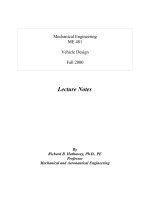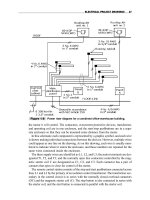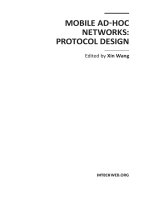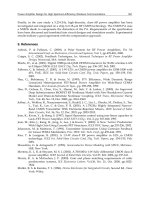Ecological Design Tenth Anniversary pptx
Bạn đang xem bản rút gọn của tài liệu. Xem và tải ngay bản đầy đủ của tài liệu tại đây (3.23 MB, 257 trang )
10th ANNIVERSARY EDITION
SIM VAN DER RYN
STUART COWA N
ecological
desig n
with a new introduction by the authors
VAN DER RYN •
COWAN
ecological d e sign
ENVIRONMENTAL DESIGN
Advance praise for
Ecological Design: Tenth Anniversary Edition:
“The publication of Ecological Design was a seminal moment for the green building
movement, and the book remains one of our most valuable and relevant texts today.
Sim Van der Ryn is one of the fathers of sustainable design, but his work transcends
time; together with Stuart Cowan, he has written a work that will inspire and inform us
for years to come.”
—S. Richard Fedrizzi, President, CEO and Founding Chairman
of the U.S. Green Building Council
“A benchmark pioneering work that remains vitally relevant today after a decade of
influencing the ecodesign community, and now with new ideas and a critical assess-
ment of the sustainability status quo in the introduction.”
—Dr. Ken Yeang, Architect and Planner, Llewleyn Davies Yeang, UK.
Praise for the original edition:
“[Ecological Design] is a ground-breaking book that will change the way we think
about buildings, agriculture, industrial processes, and our management of resources
and wastes.”
—Environmental Building News
“Visionary Van der Ryn and Cowan delight in showing us each detail of transform-
ing both consciousness and substance from ‘dumb design’ (environmentally wasteful)
to ecological design.”
—San Francisco Chronicle
SIM VAN DER RYN is the founder of the Eco-Design Collaborative, the non-profit
Ecologic Design Institute, and the Center for Regenerative Design at the College of
Marin. He has served as California State Architect, founded the University of California
Berkeley’s ecological design program, and has been a professor of architecture there
for thirty-five years. His seven books include his recent publication Design For Life.
STUART COWAN is a General Partner of Autopoiesis LLC, which offers design,
development, and finance services internationally for large-scale sustainability proj-
ects. He was a Transaction Manager at Portland Family of Funds, a community invest-
ment bank committed to green real estate projects and sustainable businesses. He
previously served as Research Director at Ecotrust.
Washington • Covelo • London
www.islandpress.org
All Island Press books are printed
on recycled, acid-free paper.
About Island Press
Island Press is the only nonprofit organization in the United States whose prin-
cipal purpose is the publication of books on environmental issues and natural
resource management. We provide solutions-oriented information to profes-
sionals, public officials, business and community leaders, and concerned citi-
zens who are shaping responses to environmental problems.
Since 1984, Island Press has been the leading provider of timely and practi-
cal books that take a multidisciplinary approach to critical environmental con-
cerns. Our growing list of titles reflects our commitment to bringing the best of
an expanding body of literature to the environmental community throughout
North America and the world.
Support for Island Press is provided by the Agua Fund, The Geraldine R.
Dodge Foundation, Doris Duke Charitable Foundation, The Ford Founda-
tion, The William and Flora Hewlett Foundation, The Joyce Foundation,
Kendeda Sustainability Fund of the Tides Foundation, The Forrest & Frances
Lattner Foundation, The Henry Luce Foundation, The John D. and Catherine
T. MacArthur Foundation, The Marisla Foundation, The Andrew W. Mellon
Foundation, Gordon and Betty Moore Foundation, The Curtis and Edith
Munson Foundation, Oak Foundation, The Overbrook Foundation, The
David and Lucile Packard Foundation, Wallace Global Fund, The Winslow
Foundation, and other generous donors.
The opinions expressed in this book are those of the author(s) and do not
necessarily reflect the views of these foundations.
Ecological Design
Tenth Anniversary Edition
Tenth Anniversary Edition
Sim Van der Ryn
Stuart Cowan
Washington
•
Covelo
•
London
Copyright © 1996 by Island Press
Introduction to tenth anniversary edition copyright © 2007 by Island Press
All rights reserved under International and Pan-American Copyright Conventions. No
part of this book may be reproduced in any form or by any means without permission
in writing from the publisher: Island Press, Suite 300, 1718 Connecticut Ave., NW,
Washington, DC 20009
ISLAND PRESS is a trademark of the Center for Resource Economics.
Library of Congress Cataloging-in-Publication Data
Ryn, Sim Van der.
Ecological design / Sim Van der Ryn and Stuart Cowan. — 10th anniversary ed.
p. cm.
Includes bibliographical references and index.
ISBN-13: 978-1-59726-140-1 (cloth : alk. paper)
ISBN-10: 1-59726-140-8 (cloth : alk. paper)
ISBN-13: 978-1-59726-141-8 (pbk. : alk. paper)
ISBN-10: 1-59726-141-6 (pbk. : alk. paper)
1. Environmental policy. 2. Human ecology. 3. Social ecology. 4. Biodiversity.
I. Cowan, Stuart, 1965– II. Title.
GE170.V36 2007
333.72—dc22
2007001639
Printed on recycled, acid-free paper
Photograph on page 2 is of the Fruehauf House in Corbett, Oregon.
Manufactured in the United States of America
10 9 8 7 6 5 4 3 2 1
CONTENTS
vii
Preface ix
Acknowledgments xiii
A Ten-Year Retrospective 2
PART ONE: Bringing Design to Life
Sustainability and Design 18
An Introduction to Ecological Design 32
Nature’s Geometry 50
PART TWO: The Ecological Design Process
Introduction: The Compost Privy Story 68
First Principle: Solutions Grow from Place 76
Second Principle: Ecological Accounting Informs Design 102
Third Principle: Design with Nature 124
Fourth Principle: Everyone Is a Designer 168
Fifth Principle: Make Nature Visible 184
Resource Guide for Ecological Design 199
Bibliography 215
Index 229
PREFACE
ix
If we are to create a sustainable world—one in which we are account-
able to the needs of all future generations and all living creatures—we
must recognize that our present forms of agriculture, architecture, en-
gineering, and technology are deeply flawed. To create a sustainable
world, we must transform these practices. We must infuse the design of
products, buildings, and landscapes with a rich and detailed under-
standing of ecology.
Sustainability needs to be firmly grounded in the nitty-gritty details
of design. Policies and pronouncements have their place, but ultimately
we must address specific design problems: How can we design our
products and manufacturing processes so that materials are completely
reclaimed? How can we create wastewater treatment systems that en-
hance, rather than damage, their surrounding ecosystems? How can we
design buildings that produce their own energy and recycle their own
wastes? How can we create agricultural systems that are not dependent
on subsidies of pesticides, fertilizers, and fossil fuels?
Design problems like these bridge conventional scientific and design
disciplines. They can be solved only if industrial designers talk to bio-
geochemists, sanitation engineers to wetland biologists, architects to
physicists, and farmers to ecologists. In order to successfully integrate
ecology and design, we must mirror nature’s deep interconnections in
our own epistemology of design. We are still trapped in worn-out me-
chanical metaphors. It is time to stop designing in the image of the ma-
chine and start designing in a way that honors the complexity and diver-
sity of life itself.
This is a book about ecological design, which can be defined as “any
form of design that minimizes environmentally destructive impacts by
integrating itself with living processes.” Ecological design is an integra-
tive, ecologically responsible design discipline. It helps connect scat-
tered efforts in green architecture, sustainable agriculture, ecological
engineering, and other fields. Ecological design is both a profoundly
hopeful vision and a pragmatic tool. By placing ecology in the fore-
ground of design, it provides specific ways of minimizing energy and
materials use, reducing pollution, preserving habitat, and fostering
community, health, and beauty. It provides a new way of thinking about
design.
This book emerges from two voices spanning several generations.
One of us has spent more than thirty years practicing, teaching, and ex-
ploring ecological design. The other, trained in science and mathemat-
ics, and with an equally strong love for the natural world, is not yet
thirty. Our respective worlds of architecture and nonlinear dynamics
meet in what Wendell Berry calls “searching for pattern.” The follow-
ing pages took form out of our dialogues devoted to this search. They
exemplify the kind of interdisciplinary dialogue that we feel is central to
ecological design.
This book is not a design handbook or a technical reference filled
with detailed case studies, charts, and tables. These details are vitally
important, but our concern here is to give them context and connect
them into a coherent whole. This book grows from the conviction that
people in very different design disciplines are beginning to struggle
with the same questions. Both automobile designers and architects are
x Preface
looking at the entire life-cycle of the materials they choose and are de-
signing in ways that allow these materials to be reclaimed. Landscape
architects and environmental engineers are working together to create
artificial wetlands to purify wastewater. Responding to this shared
quest, this book is a small step toward creating a design process that has
the preservation and restoration of the ecological commons at its core.
The first part of the book, “Bringing Design to Life,” presents an
overview of ecological design. The first chapter discusses the connec-
tion between sustainability and design. The second chapter is a self-
contained statement of the underlying principles and philosophy of
ecological design, concluding with a short history of the field. “Na-
ture’s Geometry,” the third chapter, suggests that we look for design
principles that explicitly link different levels of scale from the molecular
to the planetary.
The book’s second part, “The Ecological Design Process,” devotes
chapters to five design principles that we think are fundamental to eco-
logical design. These principles are intended as a starting point, an in-
spiration to creativity rather than a definitive set of rules.
The book concludes with a resource guide and an annotated bibliog-
raphy for those wishing to explore these concepts further. The resource
guide provides current contact information for some of the most inter-
esting projects and organizations in the field of ecological design. The
bibliography describes books that have been critical to our thinking and
to the development of ecological design.
Our discussions are, of necessity, incomplete. There is an extraordi-
nary proliferation of excellent work in ecological design, and it would
take dozens of volumes to treat it fully. Instead of striving for complete-
ness, we chose examples that best demonstrate the patterns of thought
involved in ecological design. As a result, some fields with a great deal
of significant activity—particularly renewable energy, transportation,
and urban planning—are not well represented.
xiPreface
This book would not have been possible without the extraordinary
contributions of our predecessors and contemporaries. In turn, it is of-
fered to the next generation in a spirit of hope.
Sim Van der Ryn and Stuart Cowan
xii Preface
ACKNOWLEDGMENTS
xiii
I owe a great deal to my students in ecological design seminars and stu-
dios at the University of California at Berkeley. Over the years their en-
thusiasm, questioning, and commitment to finding a better design path
was a constant source of emotional support, friendship, and intellectual
stimulation.
The Lindisfarne Association has long been an intellectual family to
me. William Irwin Thompson, its founder, and the Fellows have been
mentors, soulmates, and constant sources of inspiration. My thanks to
Beatrice Thompson, John and Nancy Todd, Wes and Dana Jackson,
Mary Catherine Bateson, Lois Bateson, Gary Snyder, Wendell Berry,
Fritz and Vivienne Hull, Amory and Hunter Lovins, Lynn Margulis,
Robert and Ellen McDermott, Robert Thurman, Richard Baker, and
Joan Halifax. Paul Hawken, David Orr, Jonathan Rose, and my friend
and former partner Peter Calthorpe provided inspiration through their
writing and work.
My work family at the Ecological Design Institute has always ac-
cepted my irregular schedule and preoccupations with patience and
good humor. Thanks especially to Peter Retondo, David Arkin, and
Marci Riseman. Conversations with Michael Katz, Christine Price,
David Harris, and Cherie Forrester were helpful in shaping the book.
The board of the Ecological Design Institute—Marty Krasney, Ranny
Riley, and Michael Murphy—has always supported my vision with good
cheer and sound advice.
Stuart Cowan enrolled in my ecological design seminar in 1992 and
brought a fresh perspective and keen intelligence to the class. A book
had been taking shape in my mind and on paper for some time. I invited
Stuart to collaborate with me, and through several years of long talks
and rambling walks through the forests and beaches of Point Reyes my
shapeless notes emerged into a new form from our joint efforts. It’s
been a pleasure to be in the company of his upbeat temperament, ener-
getic metabolism, and quick mind. Katie Langstaff, a former student
of mine and project manager of our Ecological Design Institute met
Stuart, they married, and Katie contributed her spirit and presence to
our effort.
Sim Van der Ryn
This book would have been impossible to write without the constant
care and compassion of my wife, Katy Langstaff. A fine ecological de-
signer and builder, she has challenged me to feel more deeply and write
more clearly. Her voice and spirit inform every page. Without her
courage, I would have given up on this book long ago.
I am also greatly indebted to my coauthor, Sim Van der Ryn, who
has been an extraordinary mentor and friend during a critical turning
point in my life. Thanks for the bocce ball tournaments, clam chowder,
and hikes.
I’d like to thank my parents for their love and support, and for the
opportunity to grow up with mountain, forest, and ocean companions.
Thanks to Moe Hirsch, Richard Norgaard, and Leigh Palmer, three
teachers of great integrity who have deeply influenced my path. Robin
Grossinger and Elise Brewster have been greatly valued symbionts in
the collective we call Lichen. Thanks also to the Archipelago group—
xiv Acknowledgments
Fernando Marti, Andrea Cowles, and Norm Bourassa—for some won-
derful times and much-needed support. Thanks to our patient editor,
Fran Haselsteiner, for turning an amorphous first draft into a much
more focused text. And many thanks to those friends who have pro-
vided a nourishing context for a difficult book, including David Austin,
Ann Baker, Rebecca Boone, Rebecca Coffman, Nelson Denman,
Nicole Egger, Francis Frick, Helen Hoyer, Fritz and Vivienne Hull,
Aran Kaufer, Richard Kraft, Penny Livingston, Allison and Jenn Rader,
Sarah Smith, James Stark, James Stone, Joanne Tippet, Babak Tondre,
John and Nancy Todd, and Micah Van der Ryn.
Stuart Cowan
xvAcknowledgments
Ecological Design
Tenth Anniversary Edition
A Ten-Year
Retrospective
3
This year marks the tenth anniversary of the publication of Ecological
Design. Our goal in writing the book was stated in the preface: “In or-
der to successfully integrate ecology and design, we must mirror na-
ture’s deep interconnections in our own epistemology of design.” We
sought to understand the interface of living systems and human design
by articulating five basic principles of ecological design, which emerged
from a detailed mapping and synthesis of literally dozens of candidate
principles.
One of the reasons for the continuing relevance of Ecological Design
is that these principles remain critical to creating a more sustainable fu-
ture, and the epistemology that underlies these principles is rich enough
to support a vast range of design innovation across many different
fields. The approaches we explore in this book have become widely em-
braced over the last ten years, which is heartening, but the challenges
have multiplied much more quickly.
The first principle, “Solutions Grow from Place,” states that solu-
tions grow from the unique cultural and physical characteristics of
place, which are so often ignored by standardized designs. The present-
day globalized, highly mobile economy works against knowledge of
and protection of place. All over the world, local groups are fighting to
protect their cultural and natural heritage. The ecological, material, and
human character of place is always the context of design even as the me-
chanical world is busy creating what James Howard Kunstler calls the
“geography of nowhere.”
“Ecological Accounting” is becoming a major force in architecture
and construction through the remarkably successful voluntary rating
system developed by the United States Green Building Council
(USGBC) called Leadership in Energy and Environmental Design
(LEED™). This system explicitly allows environmental and social
4 A Ten-Year Retrospective
factors, including site, water, energy, materials, and indoor air quality,
to be weighed side by side with financial metrics in the design process.
The growth of the USGBC is a testament to the exploding interest in
ecological approaches to building design. USGBC membership has
grown tenfold since 2000, and now includes over 6,300 companies and
organizations. There are LEED-certified projects in all fifty states and
twelve countries.
“Design with Nature” has found multiple expressions in the last
ten years, ranging from Janine Benyus’s groundbreaking book Biomim -
icry: Innovation Inspired by Nature and biomimicry database (http://
database.biomimicry.org) to Robert Frenay’s Pulse: The Coming Age of
Systems and Machines Inspired by Living Things. Living systems have be-
come an extremely popular metaphor, model, and measure for the built
environment, technologies, and even social institutions. Despite this,
entrenched practices in design and engineering continue to keep people
from seeing and applying the obvious, such as designing building orien-
tation and shape to reflect the movement of the sun.
“Everyone Is a Designer” is increasingly being applied by a new
breed of designers who place collaboration with all the stakeholders at
the center of their design process. It also captures the underlying im-
pulse of the open source movement, which allows an entire community
of users to collectively design software, coauthor a document (“wiki”),
or design a product.
Many open source ecological design initiatives are underway. Archi-
tecture for Humanity cofounder Cameron Sinclair recently announced
his intention to “create a community that actively embraces open source
design to generate innovative and sustainable living standards for all”
(). The Worldchanging Web site
(www.worldchanging.com) provides an international forum for sustain-
ability innovations with the intention of fostering their rapid replication.
Thinkcycle (www.thinkcycle.org) provides an open source platform for
sustainable design innovation for marginalized communities worldwide.
Finally, “Making Nature Visible,” which is linked to the concept of
biophilia developed by E. O. Wilson and Steven Kellert, is beginning to
be taken seriously by building operators and architects. Each building
and site becomes a pedagogical opportunity for the exploration of wa-
ter, energy, food, materials, waste, and biodiversity. In an increasingly
urbanized world, it is critical to make natural systems and processes vis-
ible and accessible for both children and adults. Buildings like Oberlin
College’s Adam Joseph Lewis Center and parks like Betsy Damon’s
Living Water Garden in Chengdu, China offer multiple levels of inter-
action with both ecological processes and the resources that sustain us.
In retrospect, perhaps the most compelling theme of Ecological De-
sign is the search for a unified approach to the design of sustainable sys-
tems that integrates scales ranging from the molecular to global. How
can industrial design, architecture, city and regional planning, and in-
frastructure development be woven together with the capacities and
needs of specific bioregions in the service of a world that works for all?
How can we design in a way that responds to living systems that are
continuously exchanging energy and materials and supporting self-
organizing forms across a dizzying range of scales?
The last ten years have seen extraordinary theoretical and technical
advances in the field of ecological design. Yet the challenges facing the
planet have only accelerated, ranging from the loss of biodiversity to the
rapidly increasing impacts of global climate change. The Millennium
Ecosystem Assessment, conducted by more than a thousand leading
scientists over several years, provides a recent authoritative and chilling
overview of the declining condition of dozens of ecosystem services, in-
cluding provision of fresh water, climate stability, soil health, and many
others.
1
There is a growing consensus that we have approximately one gen-
eration to make the transition from fossil fuels, ecological overshoot,
and devastating social inequity to renewable energy, stable ecosystem
services, and the ability to meet fundamental human needs. This will
5A Ten-Year Retrospective
require unwavering political will; massive economic, social, and values
transformation; and a huge reservoir of ecological design metrics, tools,
case studies, and practitioners. Ecological Design was written with the
hopeful premise that even as political and economic forces slowly
aligned with sustainability, architects, landscape architects, planners,
product designers, chemical engineers, and those in kindred disciplines
could develop comprehensive, integrated, and culturally sensitive de-
sign frameworks.
At the bioregional scale, the Conservation Economy framework
(www.conservationeconomy.net) was developed in 2002 by the innova-
tive Portland-based nonprofit Ecotrust under Stuart’s direction. This
research initiative was designed to capture the deep structure—the re-
curring economic, social, and ecological patterns—of a sustainable
bioregion at scales ranging from individual buildings to vast wildlands
corridors. The resulting “pattern language” is documented in a non-
proprietary, transparent way on a dedicated Web site using a wide range
of explanatory essays, case studies, images, references, and internal
links.
2
The goal was to create an open source platform for rapid interna-
tional diffusion, critique, and archiving of best practices around ecolog-
ical design and the social and economic factors that support it.
While the Conservation Economy framework was generated specifi-
cally for the coastal temperate rainforest of North America stretching
from Big Sur, California to Kodiak Island, Alaska, it has turned out to
have broad resonance in a wide range of other bioregions. It would ap-
pear that bioregions all over the world share a common challenge: how
to grow a postextractive economy that honors culture and place, re-
stores landscapes and stabilizes ecosystem services, enhances social eq-
uity, and provides diverse and stable livelihoods. The Conservation
Economy framework demonstrates that the principles of ecological de-
sign, applied systematically from the smallest to largest scales and sup-
ported by appropriate social institutions, can allow a resilient, enduring,
and prosperous adaptation to place.
6 A Ten-Year Retrospective
During the last few years, our close colleague Christopher Alexan-
der, an architect and mathematician who originated the pattern lan-
guage approach, has published an extraordinary four-volume series
called The Nature of Order. These books “hold out the magnificent
prospect that there are processes that ordinary people can use, in small
groups or vast collaborations, to create living structure, whether at the
scale of a single hand-painted tile, a city or a continent. These processes
use precisely the same kinds of transformation spontaneously employed
by breaking waves, developing frog embryos, spiral galaxies, or nonlin-
ear chemical reactions.”
3
Ecological Design began to apply concepts
from the new science of complex systems, including fractal geometry
and self-organization, to the design process. It will take many more
7A Ten-Year Retrospective
FIGURE 1. The Conservation Economy: a bioregional pattern language for the
coastal temperate rain forest bioregion of North America.
decades to fully effect this proposed integration. The Nature of Order
provides a kindred path to connecting science and design through
wholeness and “living structure.”
In the chapter on “Design with Nature,” we reported on early ef-
forts to undertake large-scale land-use planning that systematically con-
serves biodiversity. In the last ten years, landscape ecology, landscape
architecture, regional planning, and conservation have shown a promis-
ing convergence toward a spatial vocabulary—patch, edge, core, buffer,
corridor, matrix—and supporting design principles that protect biodi-
versity at all levels of scale. Shortly after Ecological Design appeared in
1996, Wenche E. Dramstad, James D. Olson, and Richard T. T. Forman
published Landscape Ecology Principles in Landscape Architecture and
Land-Use Planning, a highly practical reference for ecological ap-
proaches to regional planning. In 2002, Robert G. Bailey, who origi-
nated the widely used ecoregional classification system during his
tenure with the Forest Service, wrote a visionary book called Ecoregion-
Based Design for Sustainability that systematically applied ecological de-
sign at the ecoregional scale. Bailey echoed one of our key themes,
“Characteristically, conventional design tends to work at one scale at a
time. Ecological design integrates design across multiples levels of scale,
reflecting the influence of larger scales on smaller scales and smaller on
larger.”
4
The Nature Conservancy is now undertaking ecoregional planning
in its efforts to protect representative samples of key ecosystem types
and ensure habitat connectivity. Over the last ten years, the nonprofit
Wildlands Project has assisted dozens of ecoregional efforts to create ef-
fective and linked conservation reserve systems, and now promotes ef-
forts to reconnect habitat at the continental scale, including an effort to
create vast linkages along the Rocky Mountains from Yellowstone to
Yukon (Y2Y). The Y2Y initiative “is a vision of hope—of a place on the
planet that will persevere in its full high-mountain richness forever,
while continuing to provide a wonderful place for people to live, work
8 A Ten-Year Retrospective









